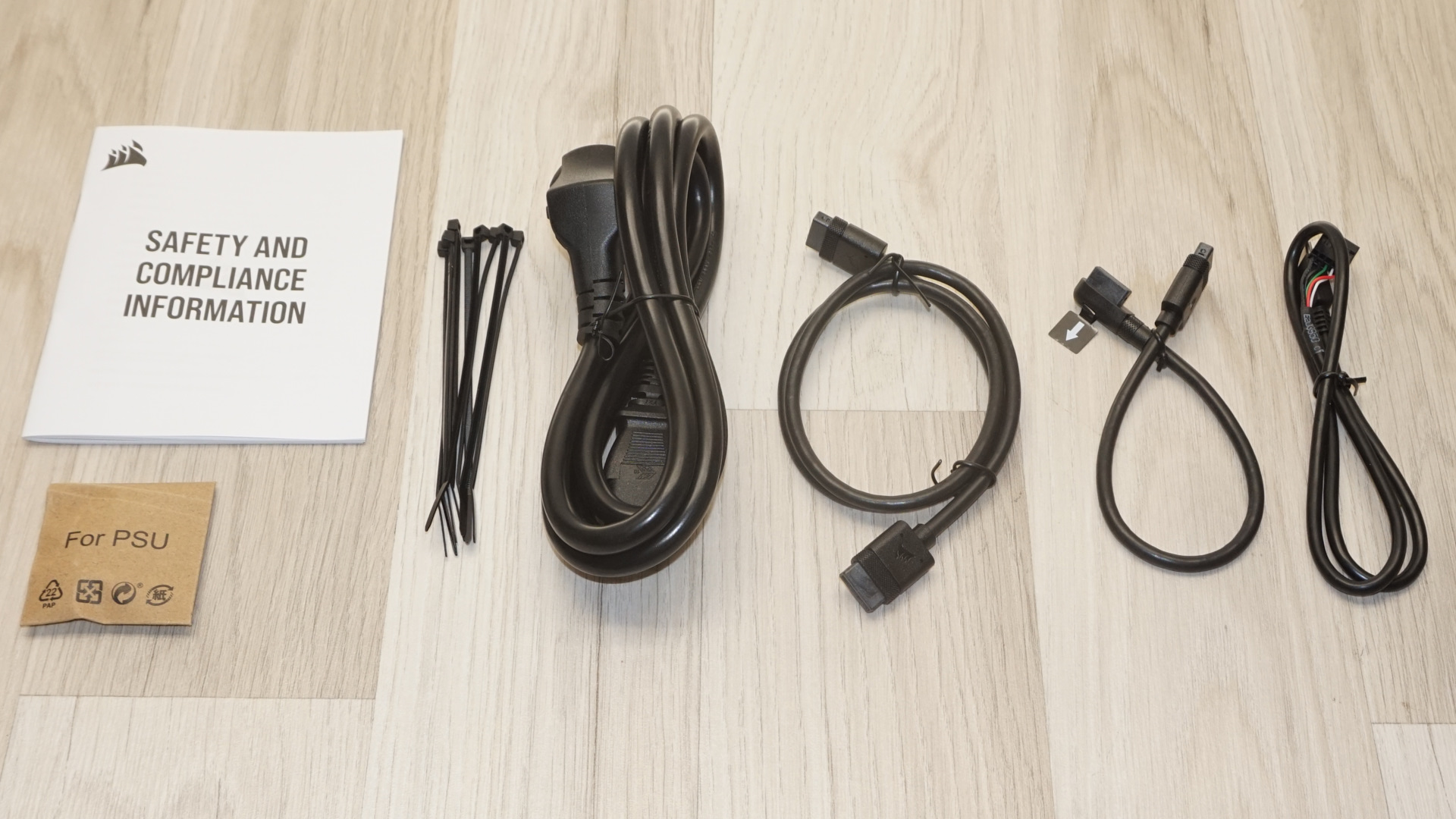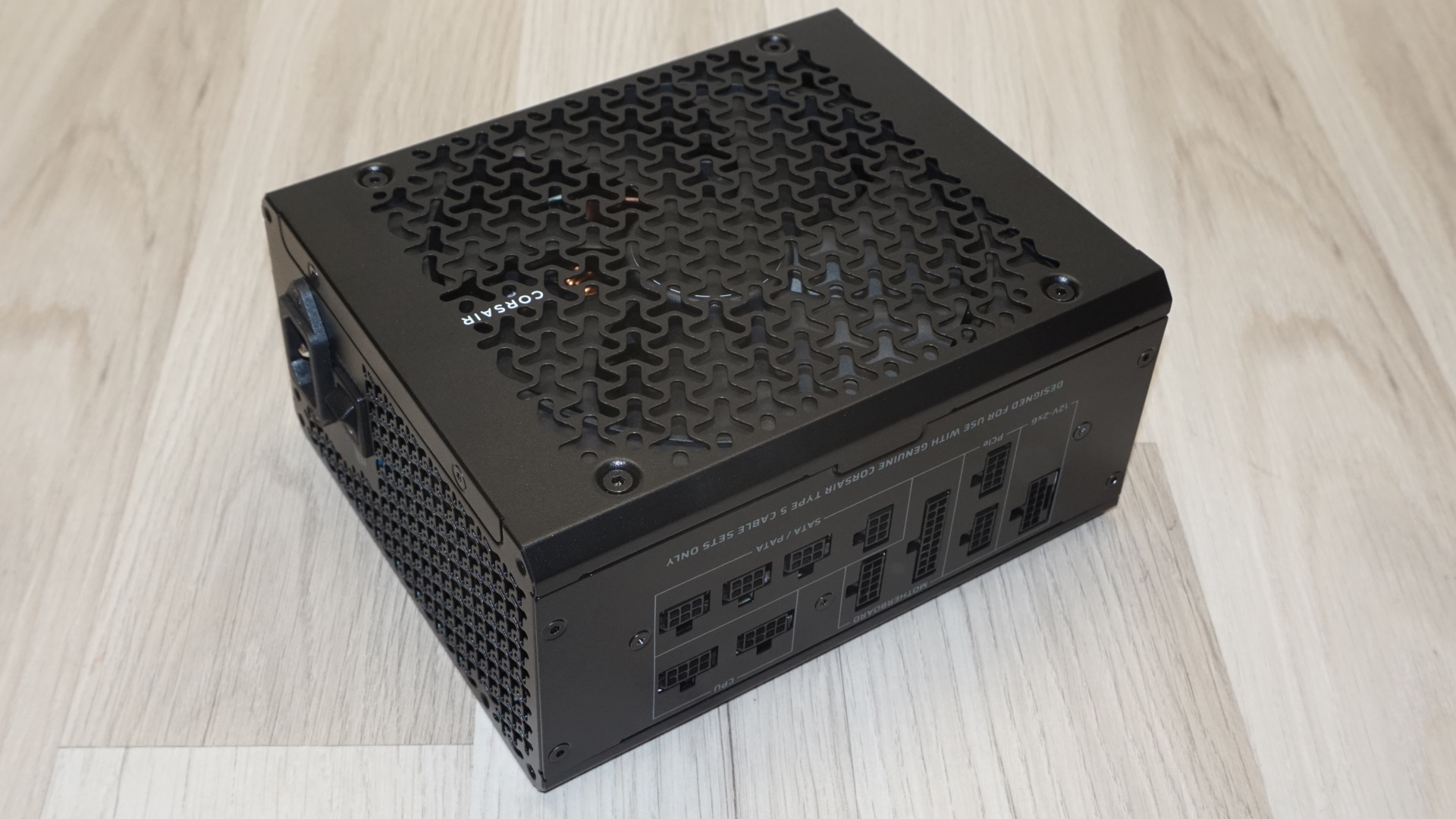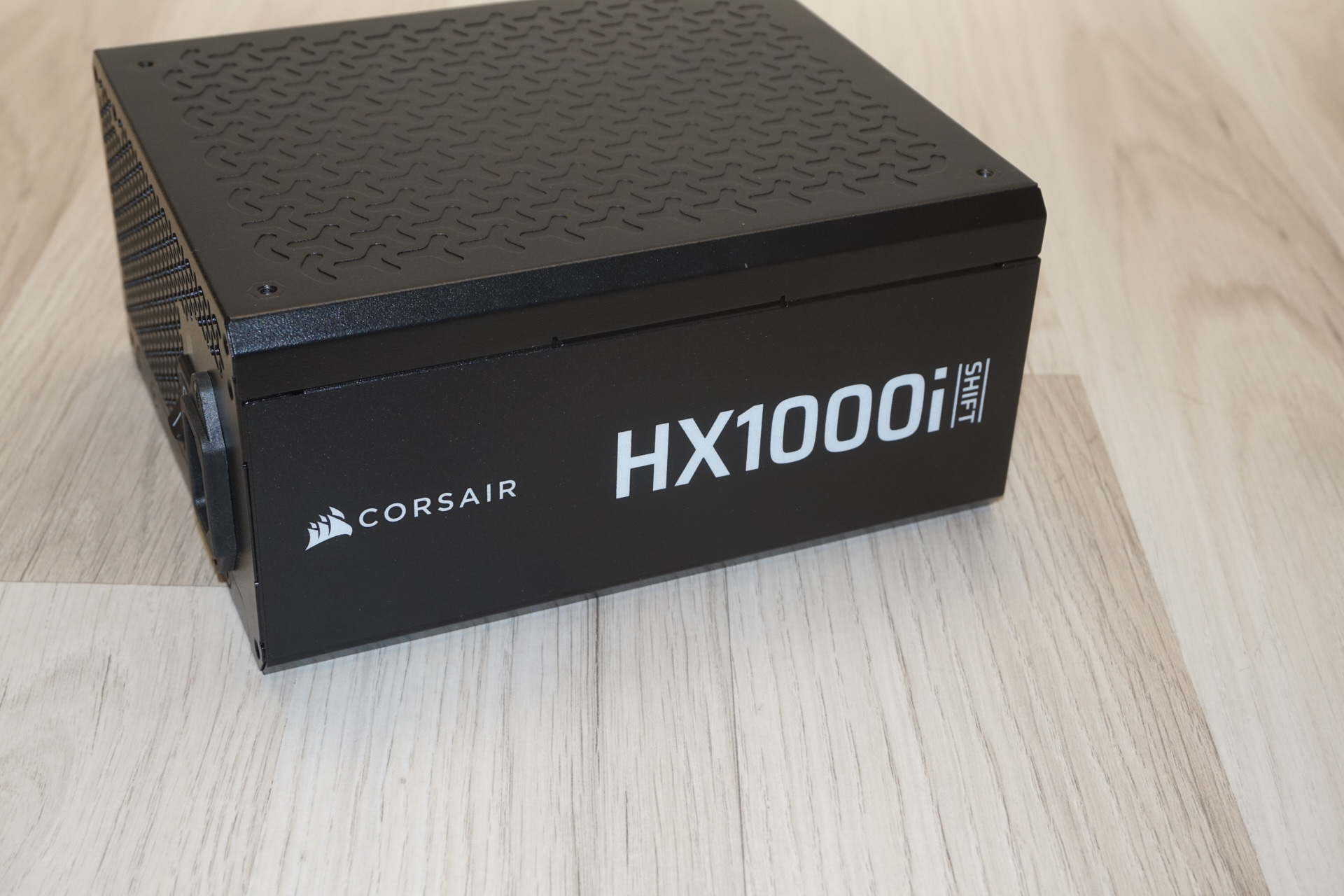Tom's Hardware Verdict
The Corsair HX1000i SHIFT reimagines PSU design by shifting modular connectors to the chassis side, enabling direct cable routing behind the motherboard that eliminates visible clutter in compatible cases. Beyond this distinctive form factor, it delivers flagship electrical performance with Cybenetics Platinum efficiency, exceptional regulation, and integrated iCUE hub functionality that consolidates ecosystem control. For Corsair ecosystem builders with appropriate hardware, it offers unparalleled cable management elegance. For others, the compromises may outweigh the benefits.
Pros
- +
Cybenetics Platinum efficiency
- +
Integrated iCUE hub
- +
Exceptional voltage regulation
- +
Revolutionary cable management
- +
Zero-RPM fan mode
- +
Outstanding ripple suppression
- +
Type-5 flat cables
Cons
- -
Limited case compatibility
- -
High retail price
- -
Single 12V-2x6 connector
Why you can trust Tom's Hardware
Corsair has built its reputation not merely through incremental refinement but through strategic innovation that occasionally reshapes market expectations. While competitors focused on efficiency percentages and modular cable designs, Corsair questioned fundamental assumptions about power supply integration. The result stands before us: the HX1000i SHIFT, a unit that literally shifts the paradigm by relocating modular connectors from their traditional rear position to the chassis side, enabling direct cable routing behind the motherboard tray.
This architectural transformation represents more than aesthetic ambition. By repositioning connectors perpendicular to conventional orientation, Corsair eliminates the visible cable management challenge entirely - assuming builders possess cases specifically designed to accommodate this radical departure from standard PSU layouts. The gamble here is not really technical – CWT’s proven record demonstrates more than adequate engineering prowess. Rather, Corsair bets that a substantial segment of premium builders will prioritize cable management perfection enough to accept reduced case compatibility and premium pricing.
The HX1000i SHIFT complicates its value proposition further through ecosystem integration. An integrated iCUE Link System Hub transforms the PSU from simple power delivery into a central control node for compatible fans, RGB lighting, and peripherals. For builders already committed to Corsair's ecosystem, this consolidation eliminates motherboard header congestion and streamlines software control. For others, it represents additional complexity without a clear benefit. The unit adheres to Intel ATX 12V v3.1 and PCIe 5.1 specifications, achieving Cybenetics Platinum certification that promises efficiency exceeding 91% at nominal loads. At its retail price surpassing $340, however, the HX1000i SHIFT faces skepticism from pragmatic builders who question whether revolutionary cable management justifies substantial premiums over conventional alternatives delivering comparable electrical performance. Although the Corsair HX1000i SHIFT did not make our best power supplies list, it still offers a compelling value for builders with the appropriate hardware.
Specifications and Design
RAIL | +3.3V | +5V | +12V | +5Vsb | -12V |
MAX OUTPUT | 25A | 25A | 83.3A | 3A | 0A |
| Row 2 - Cell 0 | 150W | 150W | 1000W | 15W | 0W |
TOTAL | 1000W | Row 3 - Cell 2 | Row 3 - Cell 3 | Row 3 - Cell 4 | Row 3 - Cell 5 |
AC INPUT | 100 - 240 VAC, 50 - 60 Hz | Row 4 - Cell 2 | Row 4 - Cell 3 | Row 4 - Cell 4 | Row 4 - Cell 5 |
MSRP | $340 | Row 5 - Cell 2 | Row 5 - Cell 3 | Row 5 - Cell 4 | Row 5 - Cell 5 |
In the Box
The Corsair HX1000i SHIFT is supplied in packaging featuring the company's signature black and yellow aesthetic theme that has become synonymous with high-end Corsair products. The sturdy cardboard construction provides substantial protection. Inside, a nylon pouch and carefully designed inserts cradle the unit during transport.
The accessory bundle expands little beyond basic necessities. Corsair includes standard mounting screws and an AC power cable, naturally, but also provides specialized cables for the integrated iCUE Link System Hub. A few cable ties round out the bundle, though builders investing this heavily in cable management are likely to employ more sophisticated solutions.
The cable situation deserves extensive discussion, as Corsair has implemented its proprietary "Type-5" cable system throughout the HX1000i SHIFT. Every cable features all-black construction with matching connectors and conductors, employing per-wire sleeving that provides visual appeal without the bulk of traditional braided solutions. More significantly, these cables utilize smaller connectors on the PSU side, the same type employed by the 12V-2x6 standard, enabling higher density at the modular panel while maintaining robust current-carrying capability.

The connector configuration reveals strategic decisions about the target audience. The 1000W model provides a single 12V-2x6 connector capable of delivering up to 600W to compatible graphics cards, alongside four traditional 6+2 pin PCIe connectors for broader compatibility. Corsair implements clever multiplexing: two of the 6+2 PCIe connectors share the 12V-2x6 socket on the PSU side, allowing builders to either deploy the modern connector alongside two legacy connectors, or utilize four legacy connectors while abandoning 12V-2x6 capability entirely. This flexibility addresses transition-period hardware combinations, though the presence of only a single 12V-2x6 connector could prove limiting in the future. Note that only the 1500W variant provides two native 12V-2x6 connectors.
Get Tom's Hardware's best news and in-depth reviews, straight to your inbox.
Connector type | Hardwired | Modular |
|---|---|---|
ATX 24 Pin | - | 1 |
EPS 4+4 Pin | - | 2 |
EPS 8 Pin | - | - |
PCI-E 5.0 | - | 1 |
PCI-E 8 Pin | - | 4 |
SATA | - | 8 |
Molex | - | 8 |
Floppy | - | - |
External Appearance
Corsair designed the HX1000i SHIFT to combine functional innovation and aesthetic aggression. The chassis receives a matte black paint finish that demonstrates exceptional quality - resistant to fingerprints, immune to casual scratching, and finished to tolerances that eliminate any trace of budget manufacturing techniques. At 170mm depth, the HX1000i SHIFT extends beyond the ATX standard's 140mm recommendation. Nevertheless, the shifted modular panel mounted on the left side of the chassis is what represents the defining feature, dramatically altering cable routing geometry compared to traditional rear-mounted configurations and necessitating compatibility verification. This placement allows cables to exit directly toward cable management channels behind the motherboard tray, but only in cases specifically designed to accommodate this unconventional layout.
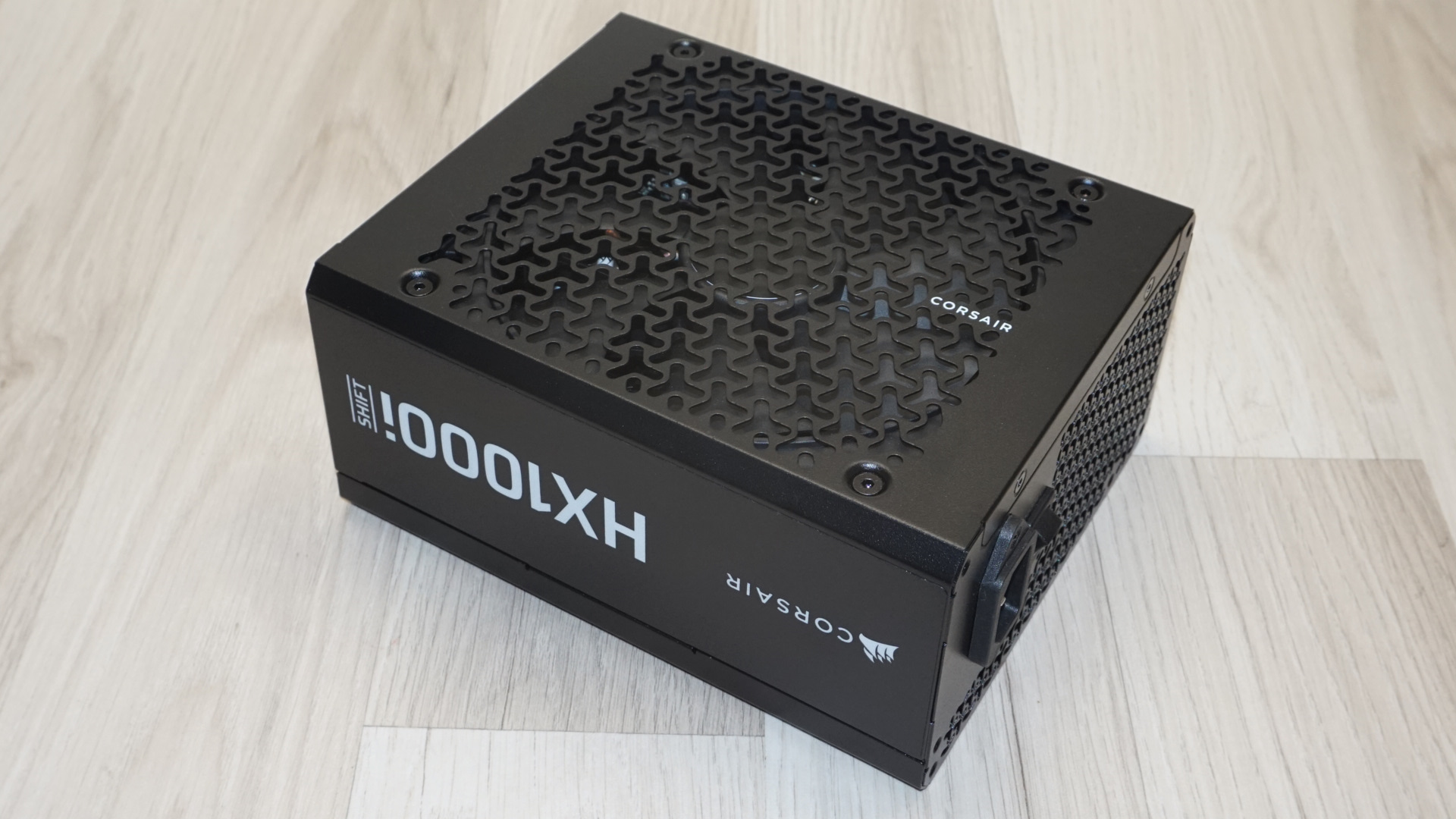
The front panel maintains minimalist elegance with a standard AC receptacle and on/off switch. A basic decorative sticker adorns the right side, while the fan grille integrated into the top surface features a distinctive "fidget spinner" pattern. The same geometric motif appears embossed into the top of the chassis itself. The rear panel hosts the electrical specifications and certifications sticker, documenting the unit's capabilities for reference without disrupting the overall aesthetic. The left side panel presents the modular connector array with subtle printed legends identifying each socket's purpose. These connectors are notably smaller than what we typically find.
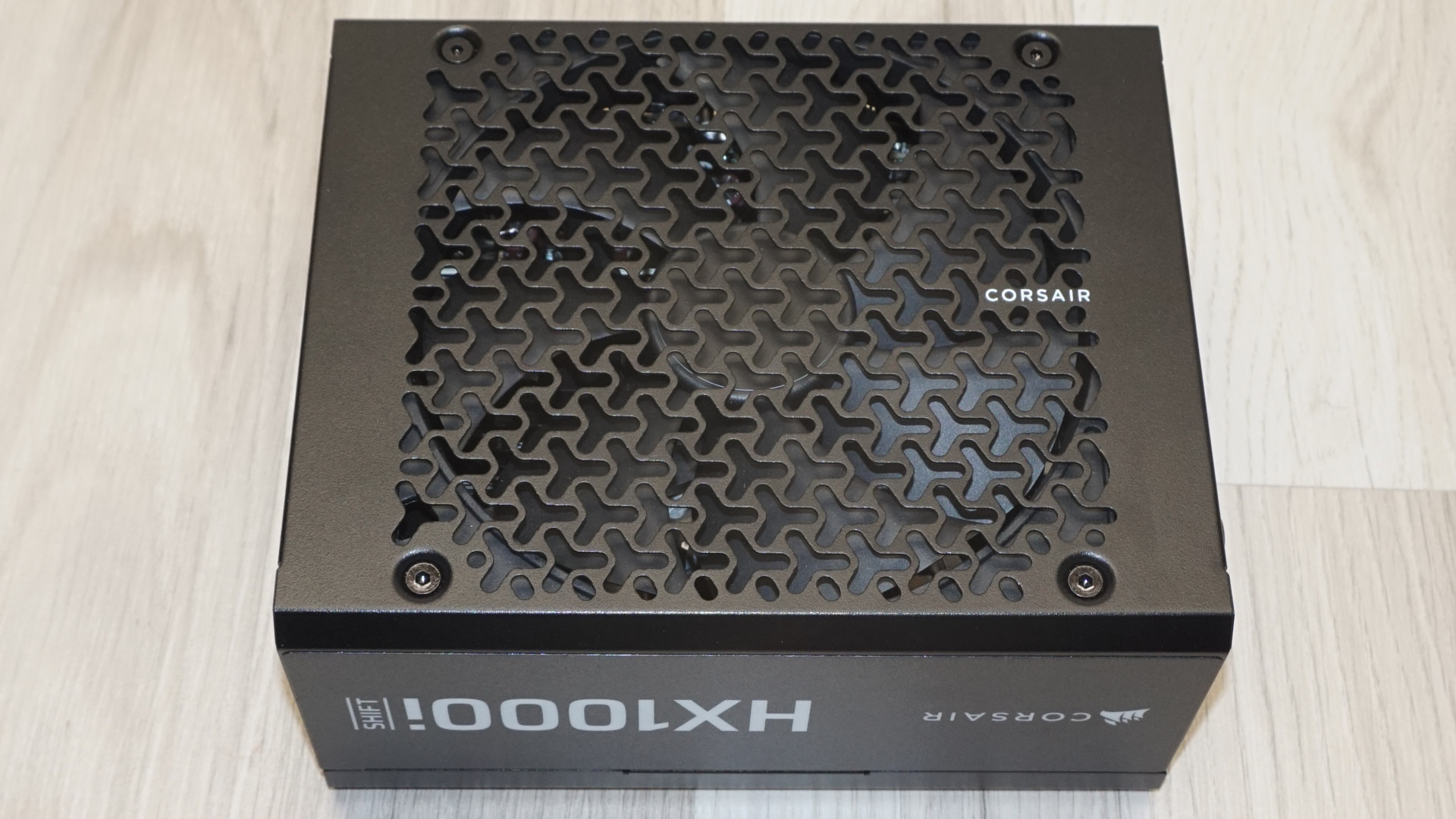
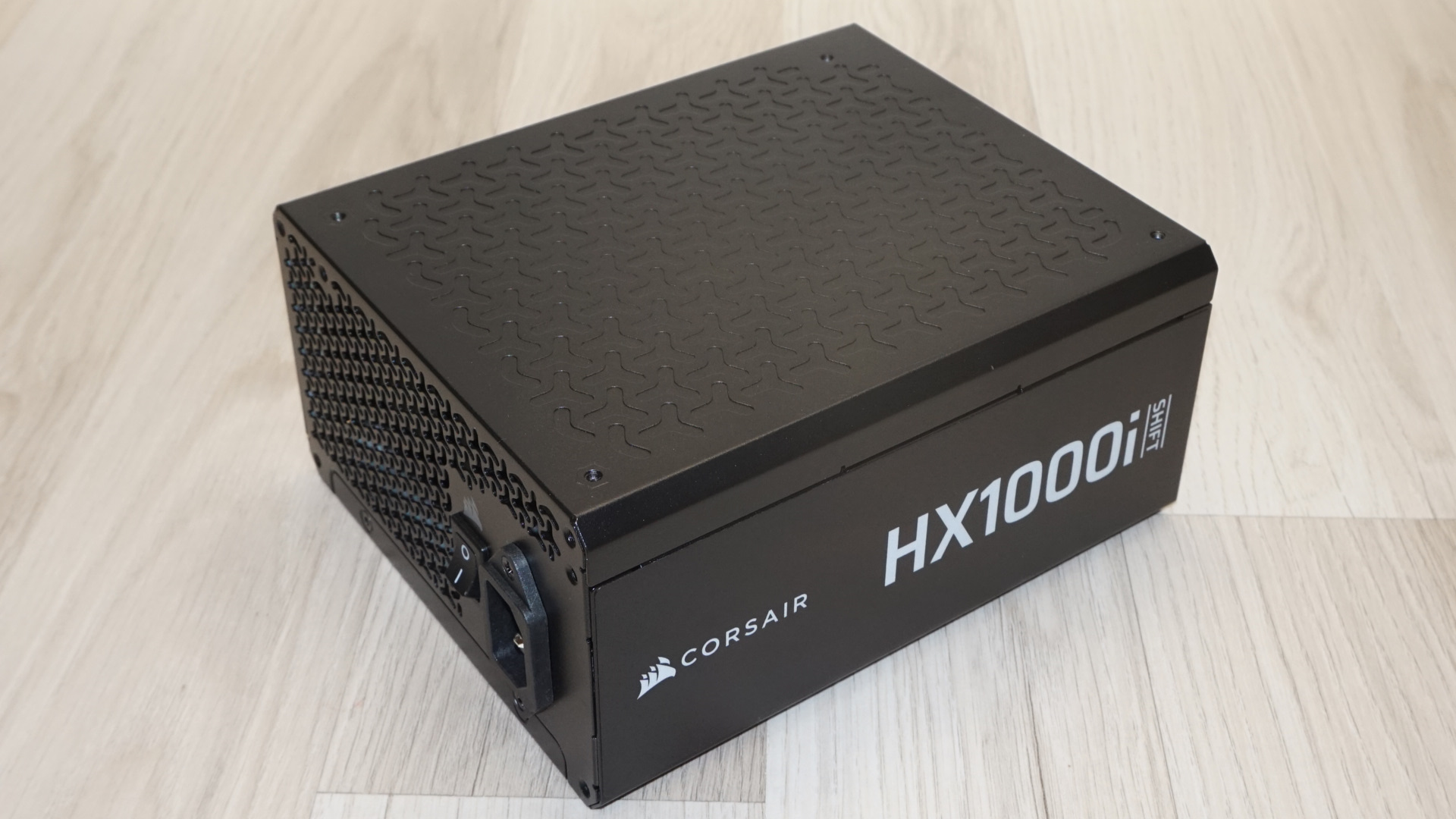
Perhaps most intriguing, Corsair has integrated iCUE Link System Hub functionality directly into the PSU chassis. Dedicated connectors for iCUE device cables appear alongside a somewhat mysterious tachometer 2-pin connector, transforming the power supply into a central hub for ecosystem management. For Corsair loyalists, this integration eliminates separate hub hardware and simplifies RGB/fan control. For others, it represents features that may never activate.
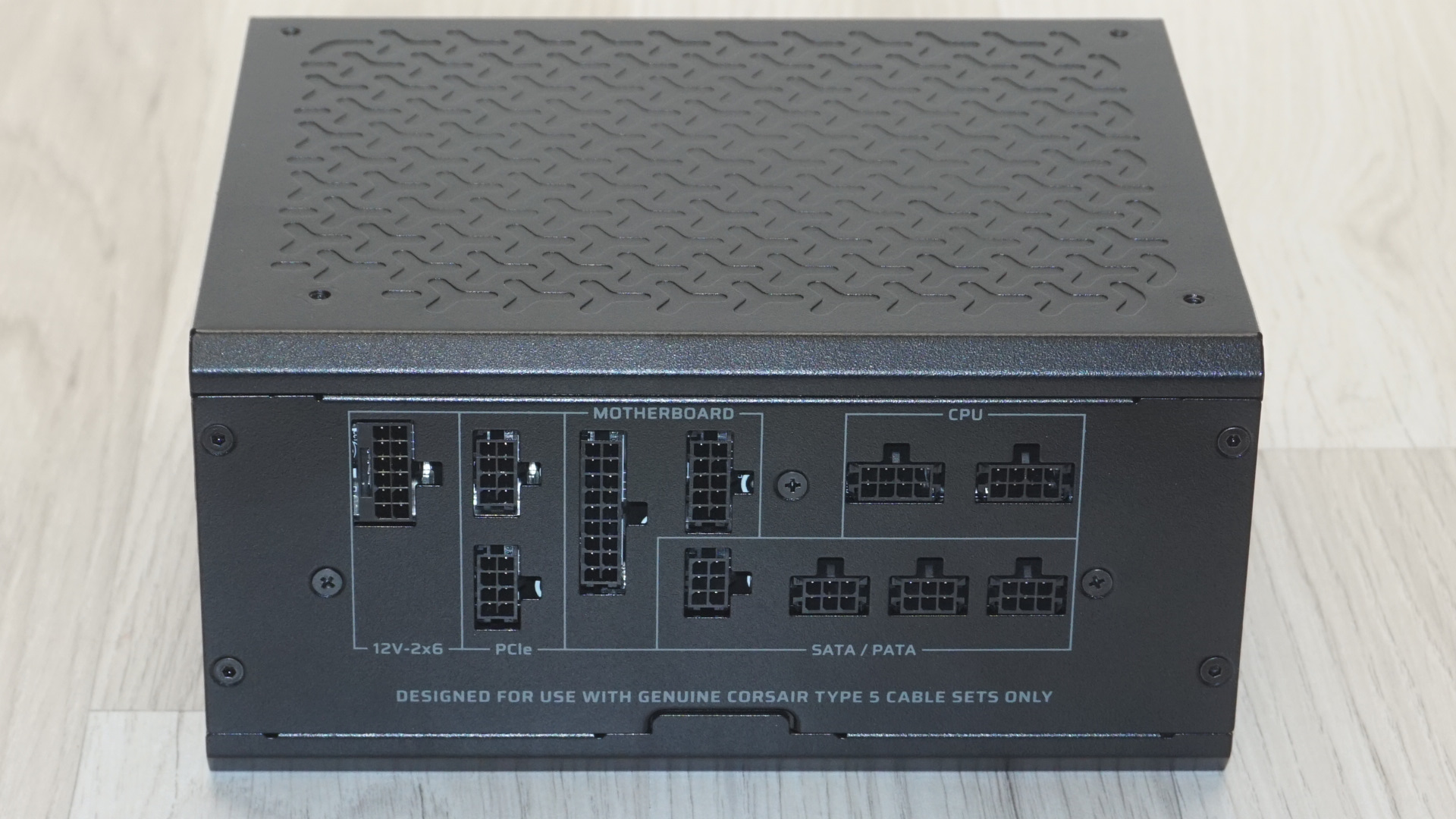
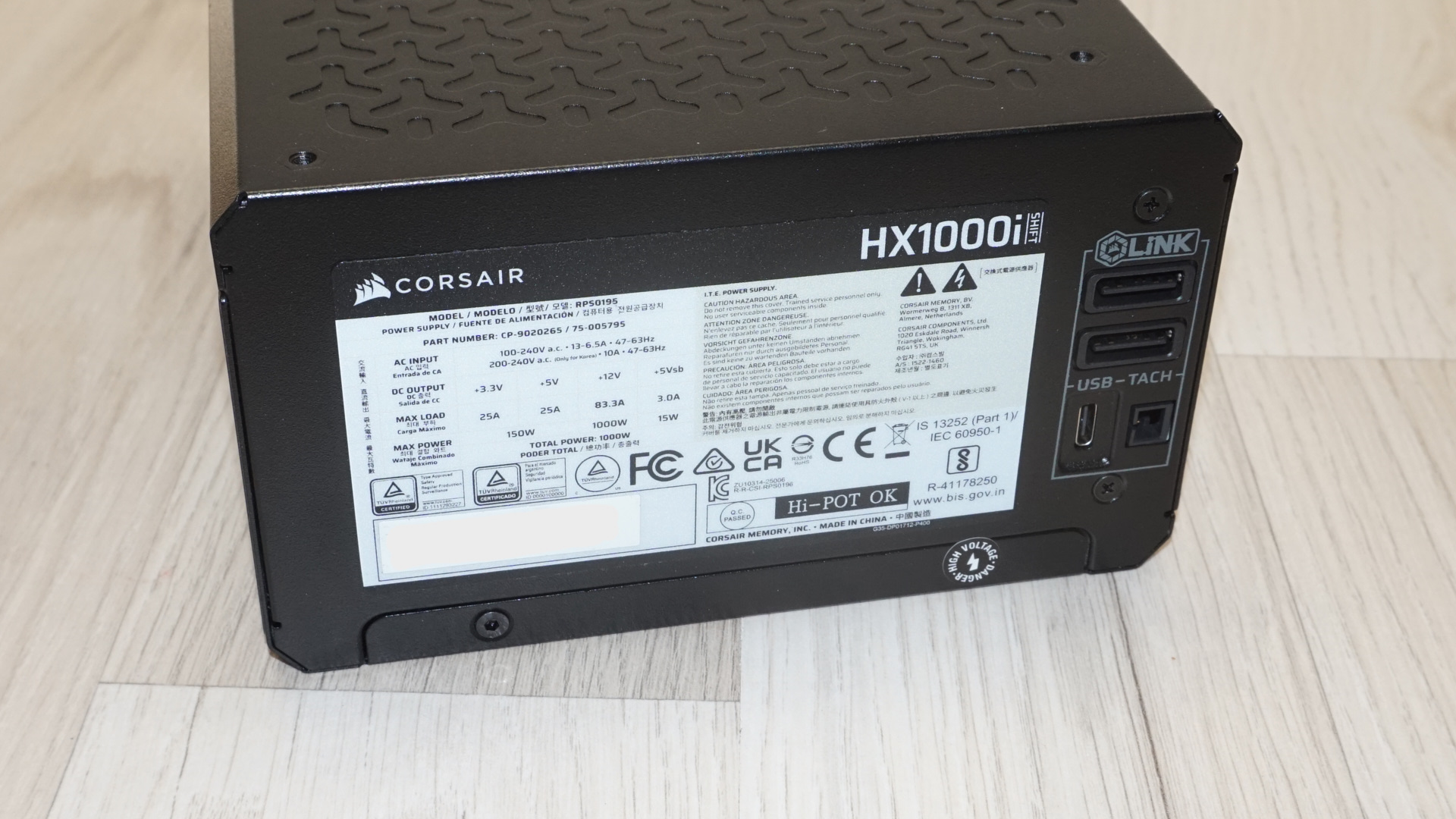
Internal Design
A Corsair NR140HP 140mm fan equipped with a fluid dynamic bearing (FDB) engine handles thermal management duties. FDB technology represents the premium tier of fan bearing designs, offering exceptional reliability and remarkably quiet operation compared to sleeve or rifle bearing alternatives. These fans maintain low acoustic signatures even at elevated speeds while delivering MTBF figures that support Corsair's ten-year warranty confidently. While Corsair hasn't published detailed specifications for this particular fan model, testing reveals maximum rotational speeds approaching 2300 RPM – a very high top speed that the unit's thermal control circuitry ensures remains untapped during typical operating conditions.
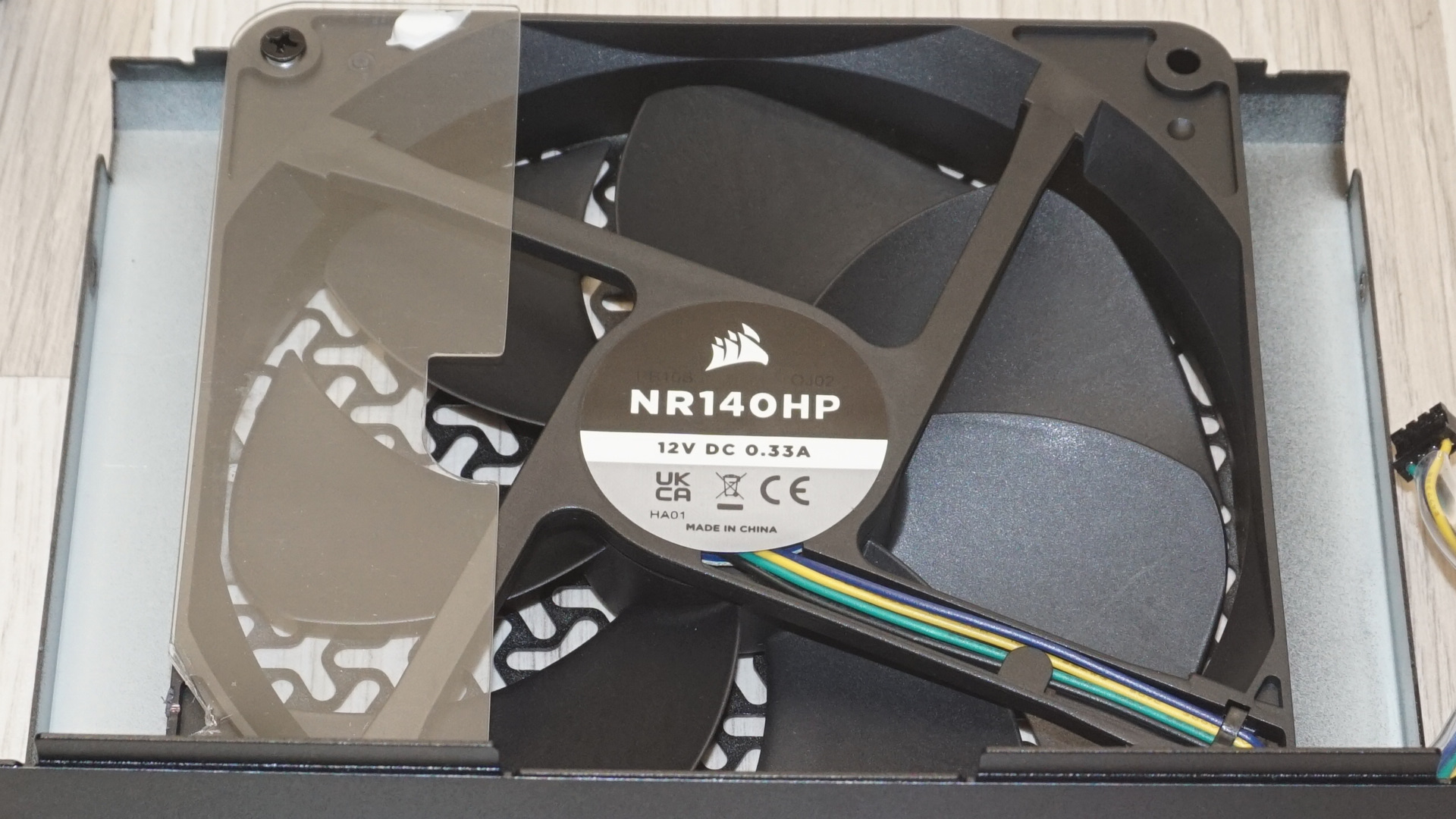
Channel-Well Technology serves as the OEM behind this platform, a choice that brings decades of experience designing mid-to-top tier power supplies for numerous brands. CWT's engineering prowess has graced many enthusiast-grade products, establishing the Taiwanese manufacturer as a reliable partner for premium PSU development. The core design philosophy here does not deviate dramatically from conventional high-end units. We have active PFC, synchronous rectification, DC-to-DC conversion for minor rails, etc. However, the PCB orientation rotates 90 degrees clockwise to accommodate the side-mounted connector arrangement. This seemingly simple transformation actually demands comprehensive redesign, as component placement, heat dissipation paths, and electrical routing all shift to maintain performance within the altered geometry.
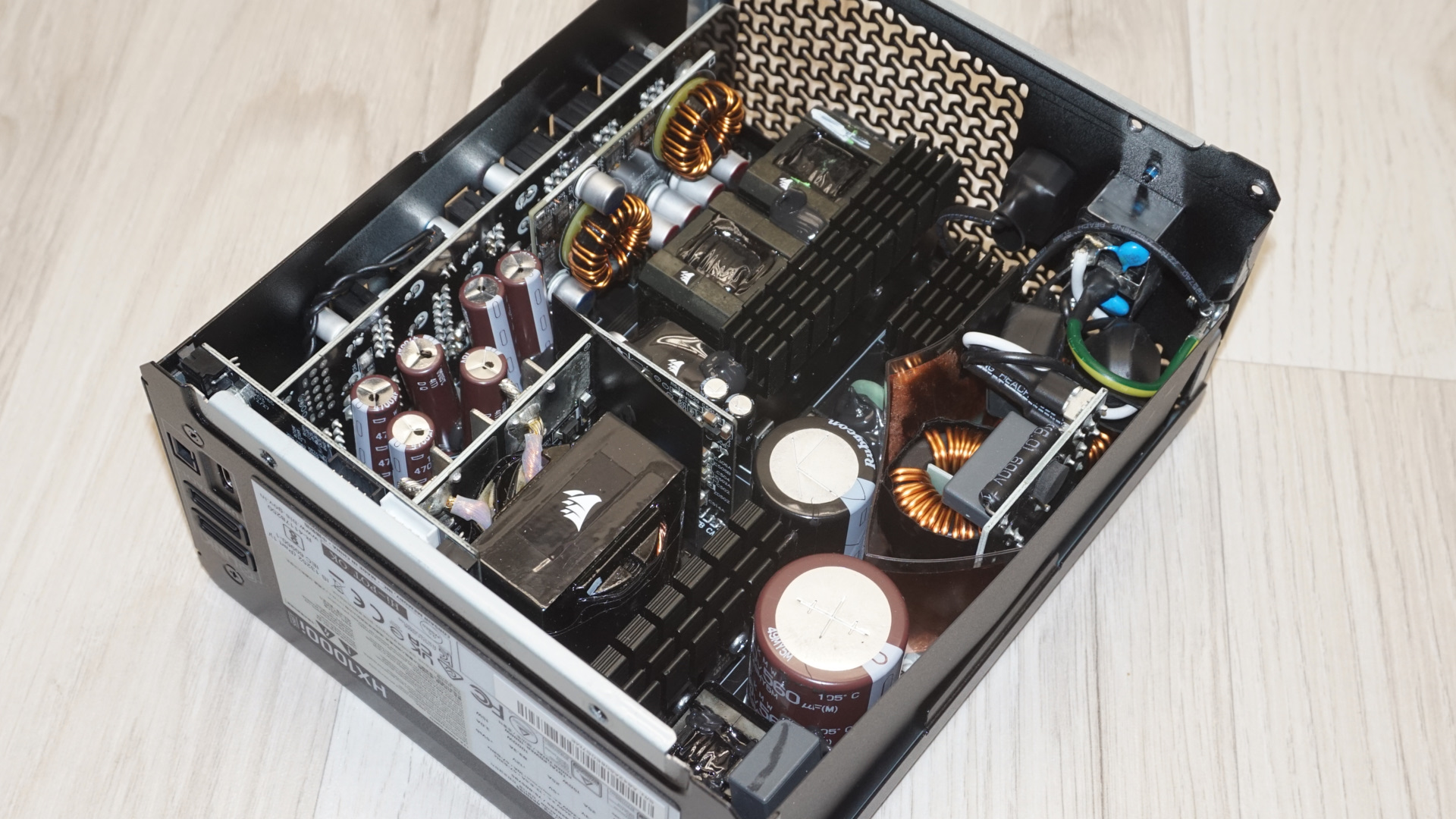

The input filtering stage implements robust protection with six Y capacitors, two X capacitors, and two filtering inductors, a configuration that exceeds minimum requirements substantially. Two rectifying bridges mount on a shared heatsink immediately following filtration.
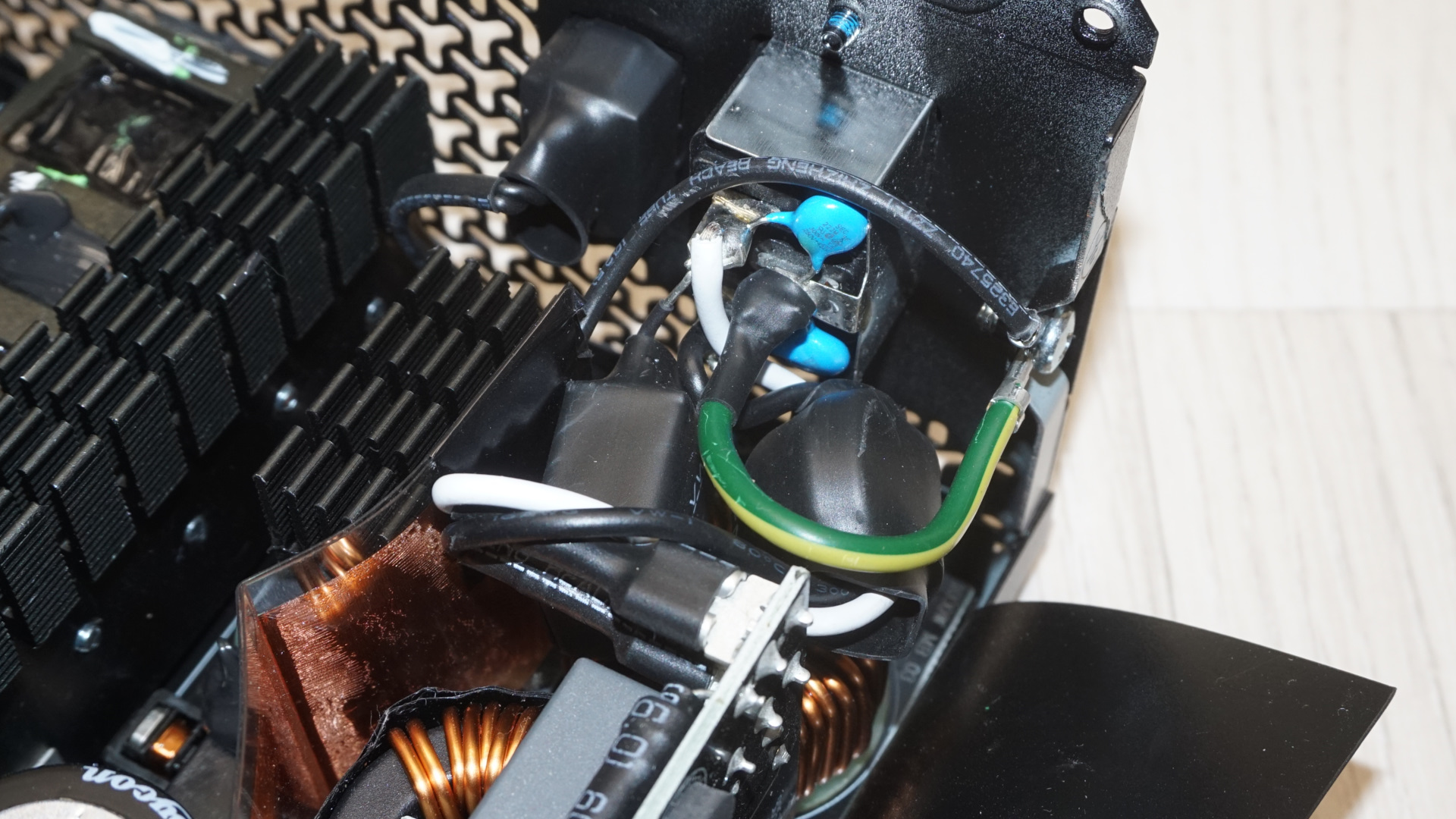
The APFC circuitry demonstrates a more sophisticated approach to power factor correction. Two Infineon 60R099P6 MOSFETs handle primary active PFC duties, assisted by an enhancement MOSFET (SPN5003) that improves low-load efficiency - a configuration CWT has deployed across several recent platforms with excellent results. This digital interleaved PFC topology enables superior efficiency characteristics across the load range compared to conventional approaches. A Nippon Chemi-Con 560 μF unit paired with a Rubicon 470 μF capacitor and two encased inductors are the passive components of the APFC circuit.
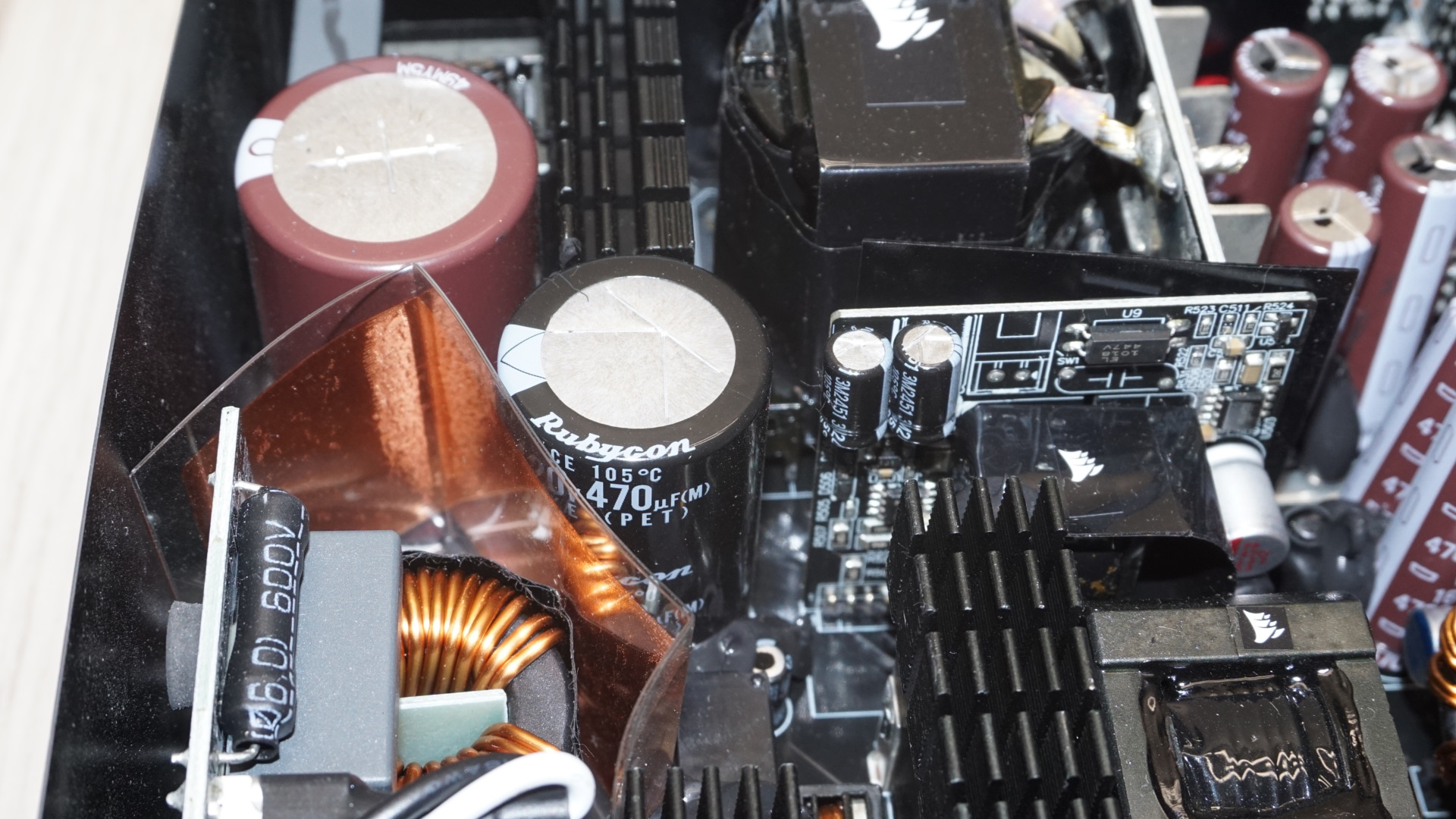
The primary inversion stage employs two Infineon 60R099P6 MOSFETs configured in a half-bridge topology, mounted on substantial heatsinks alongside the main transformer. These heatsinks provide ample thermal dissipation area for such efficient MOSFETs, suggesting a rather conservative thermal design. The secondary side implementation places ten Infineon 014N04LS MOSFETs on a vertical daughterboard for synchronous rectification, generating the primary 12V rail, a generous allocation that distributes thermal loads and ensures excellent efficiency. Corsair employs the same MOSFET type throughout, including on the separate DC-to-DC converter circuits on another vertical daughterboard that generate the 3.3V and 5V rails. The capacitor selection throughout the secondary side draws exclusively from reputable Japanese manufacturers: Nippon Chemi-Con, Rubycon, and Nichicon products dominate the bill of materials.
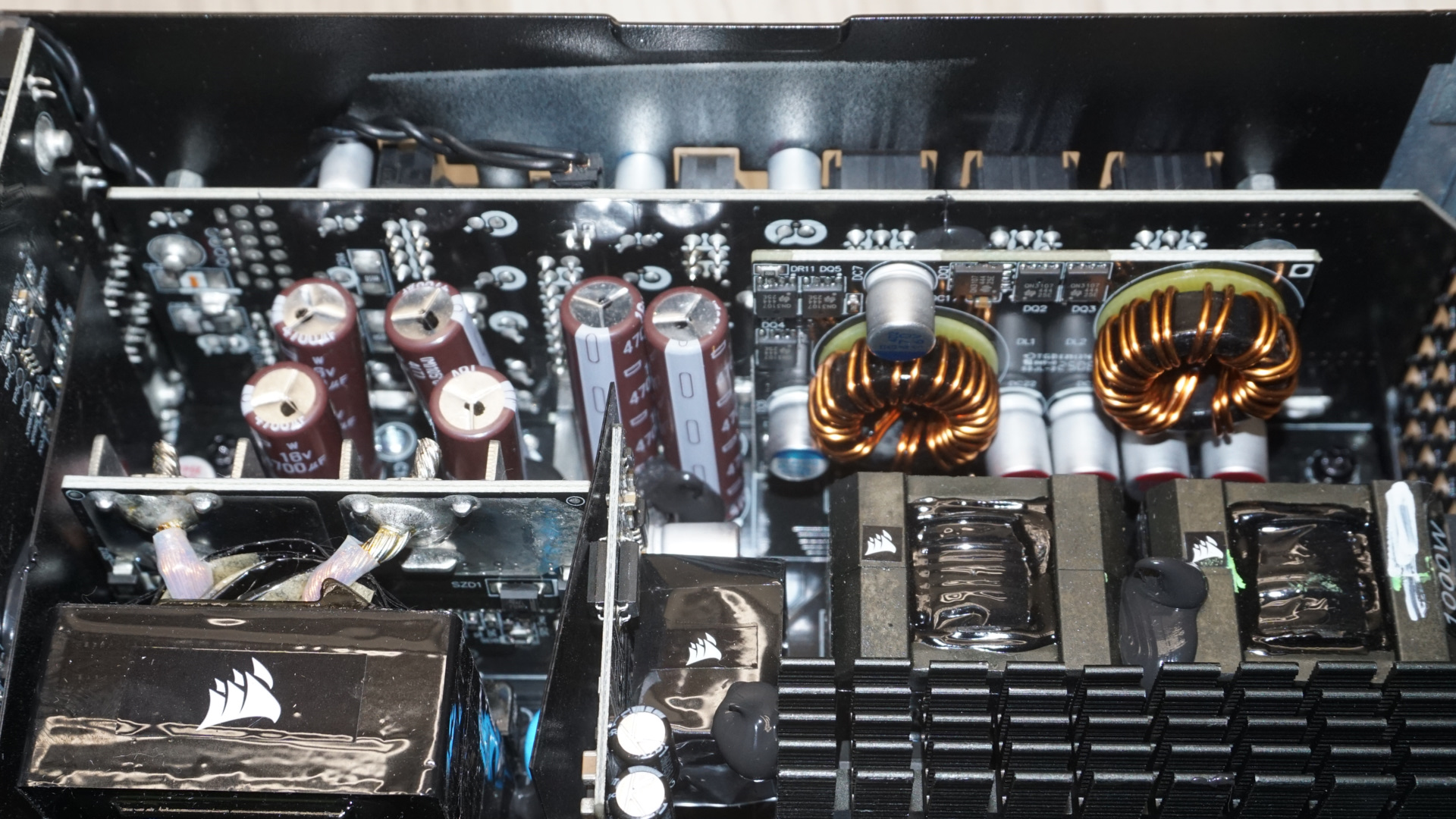

One notable architectural decision: the HX1000i SHIFT completely omits the -12V rail, recognizing this legacy specification as a liability that offers no practical benefit for modern systems.
Cold Test Results
Cold Test Results (25°C Ambient)
For the testing of PSUs, we are using high precision electronic loads with a maximum power draw of 2700 Watts, a Rigol DS5042M 40 MHz oscilloscope, an Extech 380803 power analyzer, two high precision UNI-T UT-325 digital thermometers, an Extech HD600 SPL meter, a self-designed hotbox and various other bits and parts.
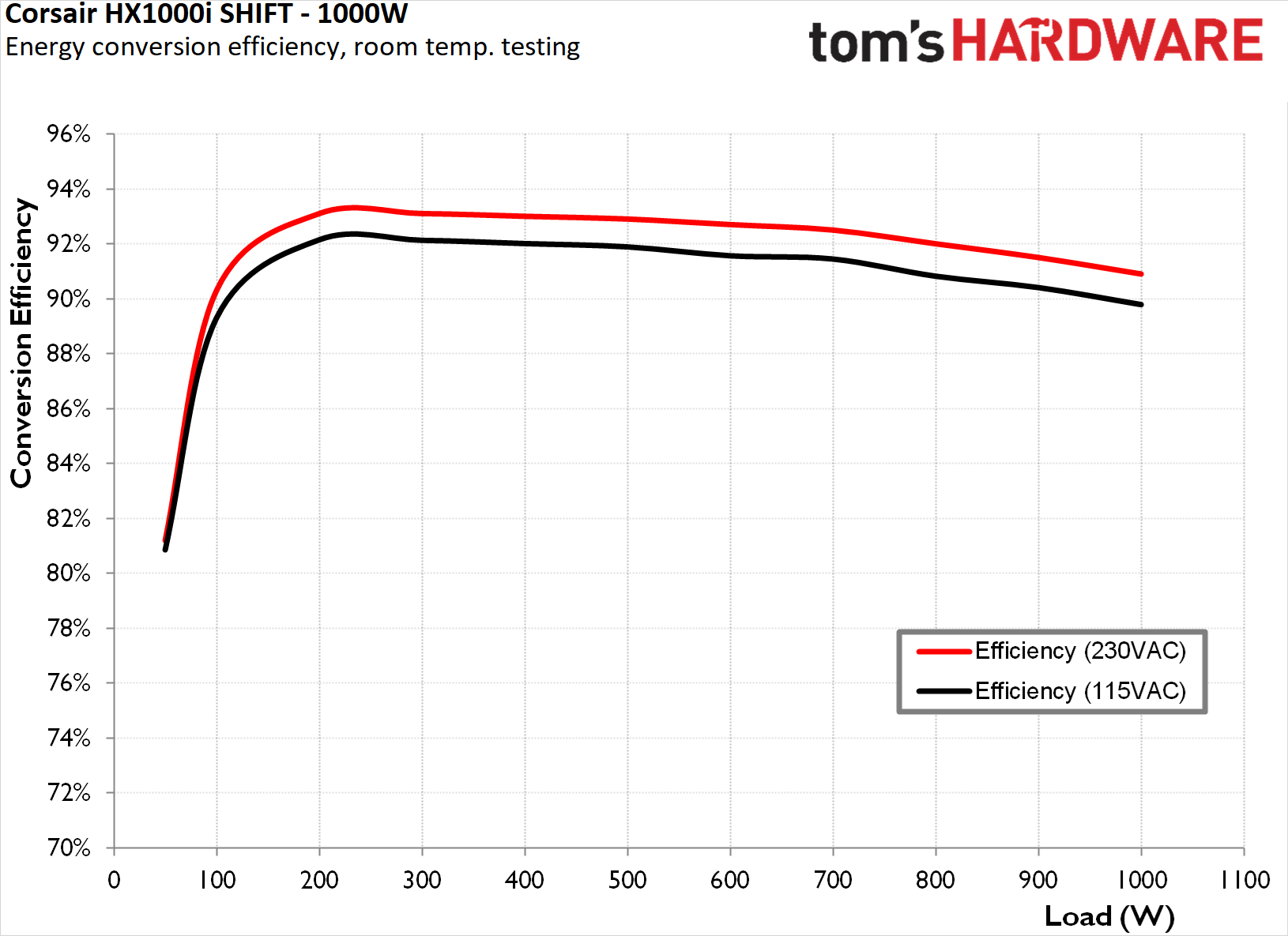
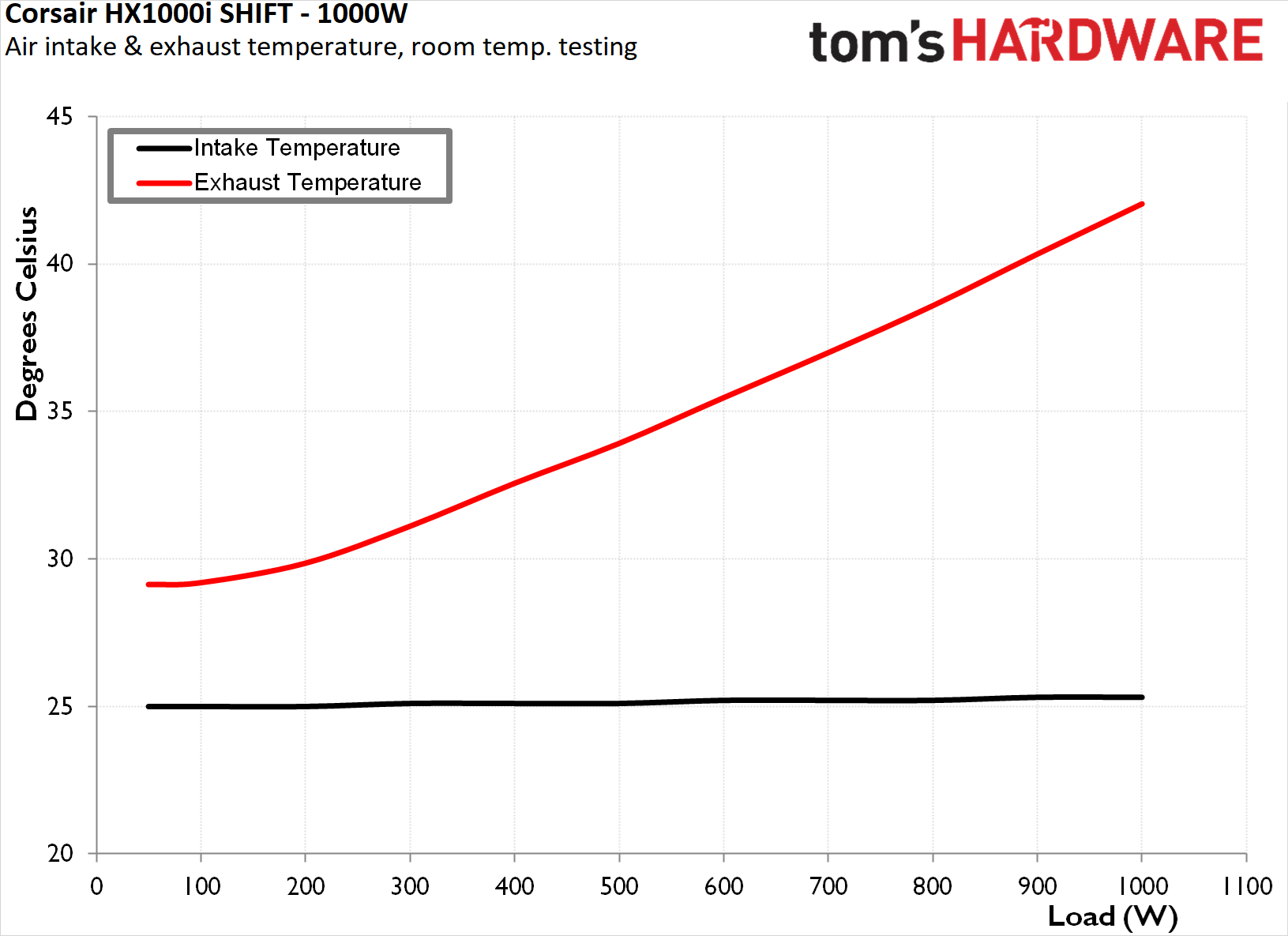
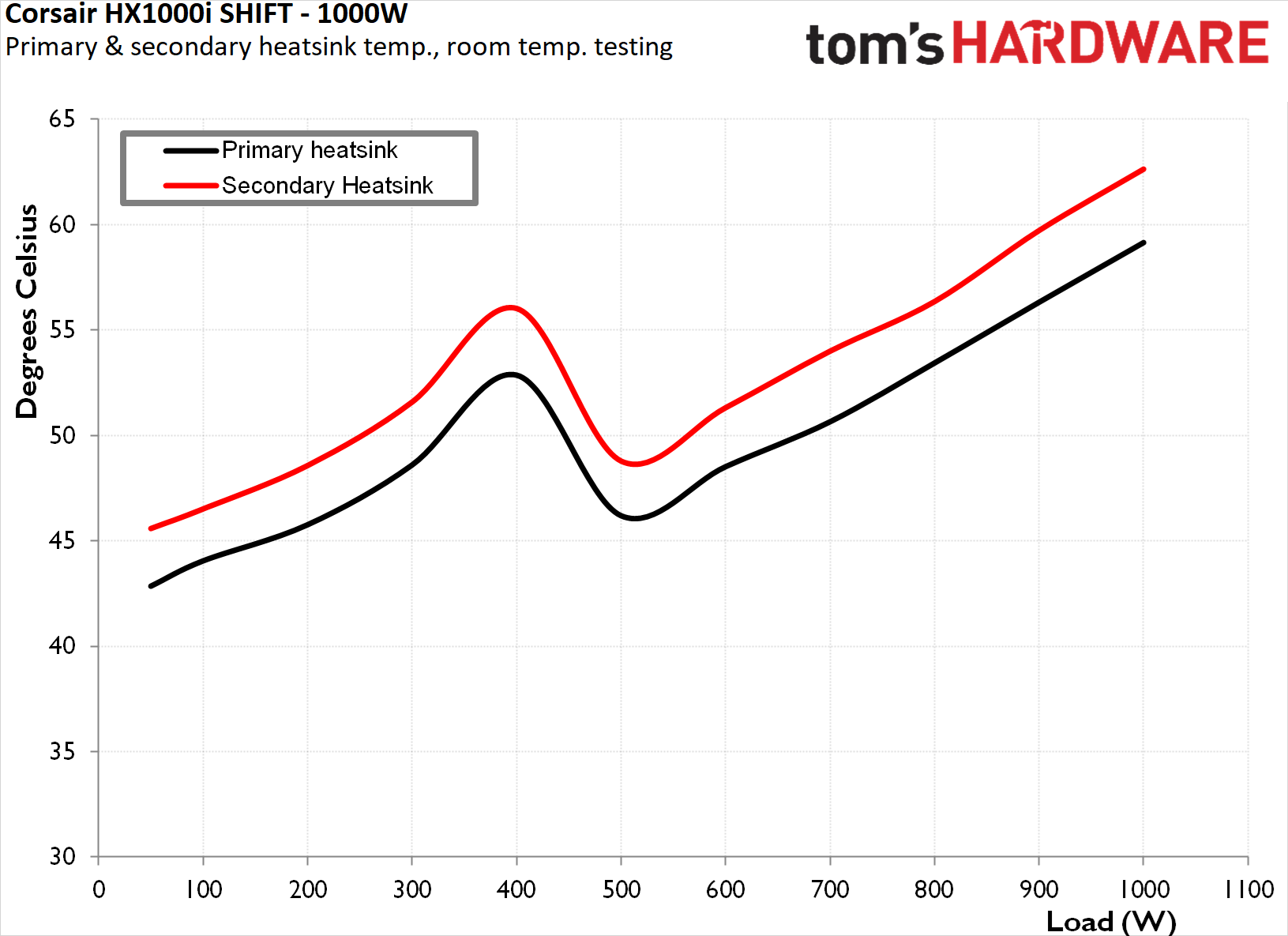
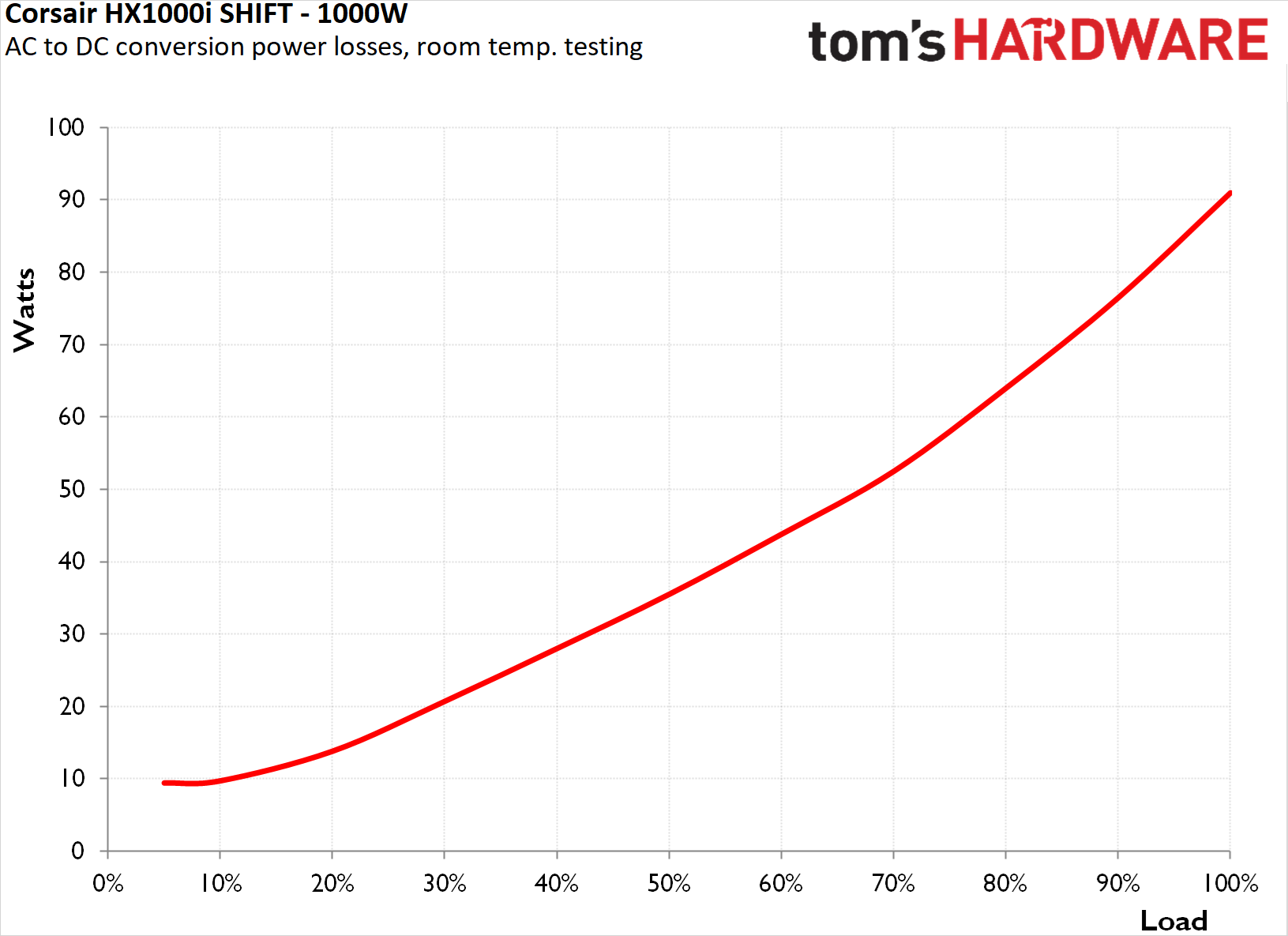
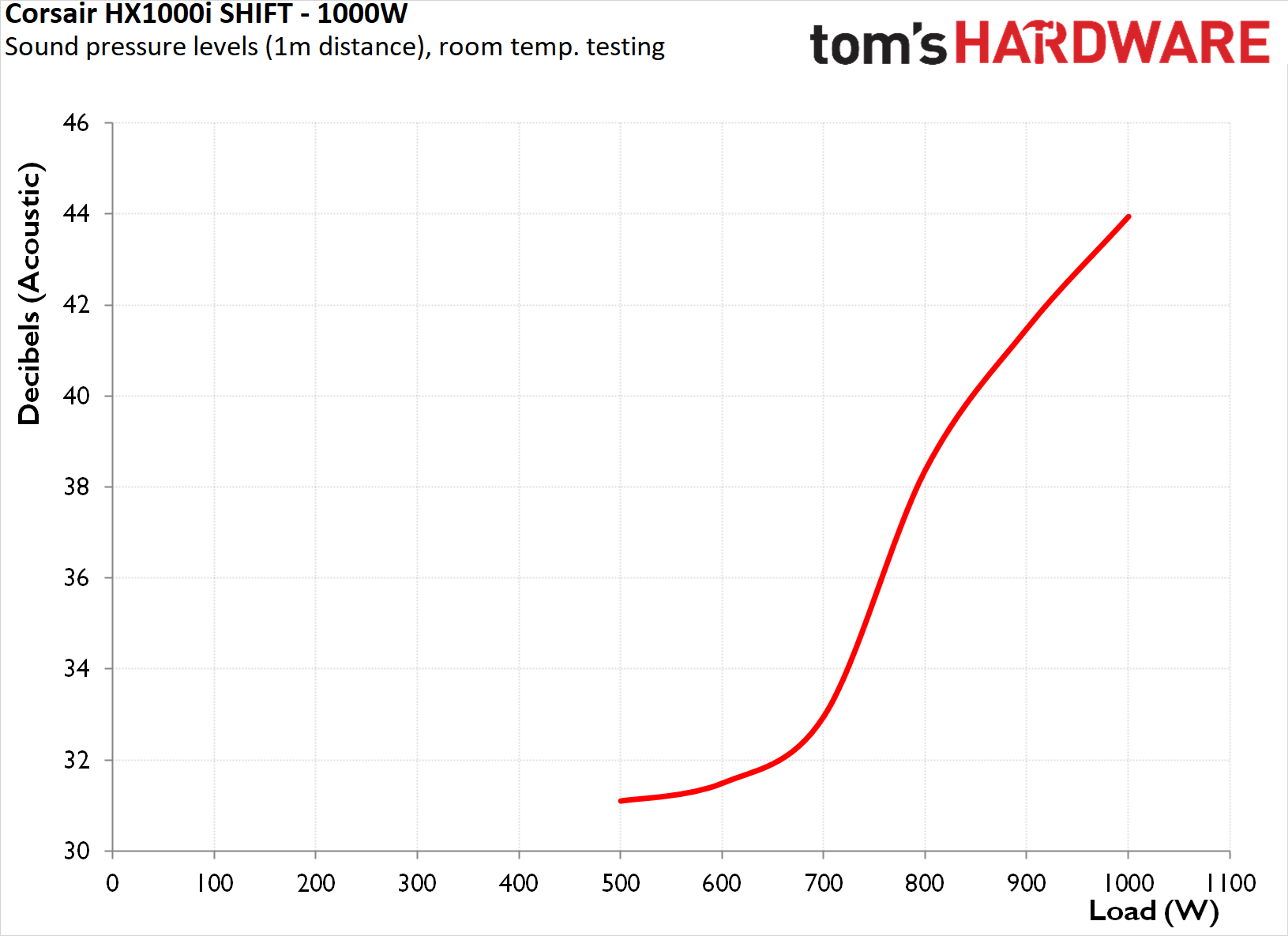
Under controlled cold testing conditions with 25 °C ambient temperature, the Corsair HX1000i SHIFT delivered efficiency performance that comfortably satisfies its Cybenetics Platinum certification. At 115 VAC input voltage, the unit achieved an average nominal load efficiency of 90.7%, while 230 VAC input improved performance to 92.2%, figures that place this unit firmly in flagship territory. It actually misses the Cybenetics Titanium certification by a very small 0.3% margin. The efficiency curve exhibits great behavior, peaking at approximately 40% load before declining gradually as power draw increases. This efficiency profile remains remarkably stable across most of the operational range, never dropping precipitously even as loads approach maximum capacity. Very low load efficiency proves quite good for a kilowatt-class unit as well.
The fan behavior during cold testing reveals sophisticated thermal management programming. The NR140HP fan remains completely inactive until load reaches approximately 500W, but notably does not activate immediately at this threshold. Instead, the unit appears to be requiring some sustained loading before the fan activates. This suggests advanced thermal control circuitry that will only start the fan when it is absolutely necessary to do so, preventing unnecessary fan cycling during brief load spikes. Once active, the fan maintains relatively low speeds across most of the load range, never approaching anywhere near its maximum 2300+ RPM capability. Internal temperatures remain very low throughout testing, indicating that the thermal design provides substantial headroom and that Corsair has prioritized longevity and acoustic comfort over minimal heatsink investment.
Hot Test Results
Hot Test Results (~45°C Ambient)
Elevated ambient temperature testing reveals the HX1000i SHIFT's good resilience to thermal stress under adverse operating conditions. Average nominal load efficiency measures 90.1% at 115 VAC and 91.4% at 230 VAC, representing a measurable but reasonable degradation from cold test results. The highlight is that there are no signs of thermal stress and the efficiency of the unit remains stable even when it is very heavily loaded for prolonged periods of time.

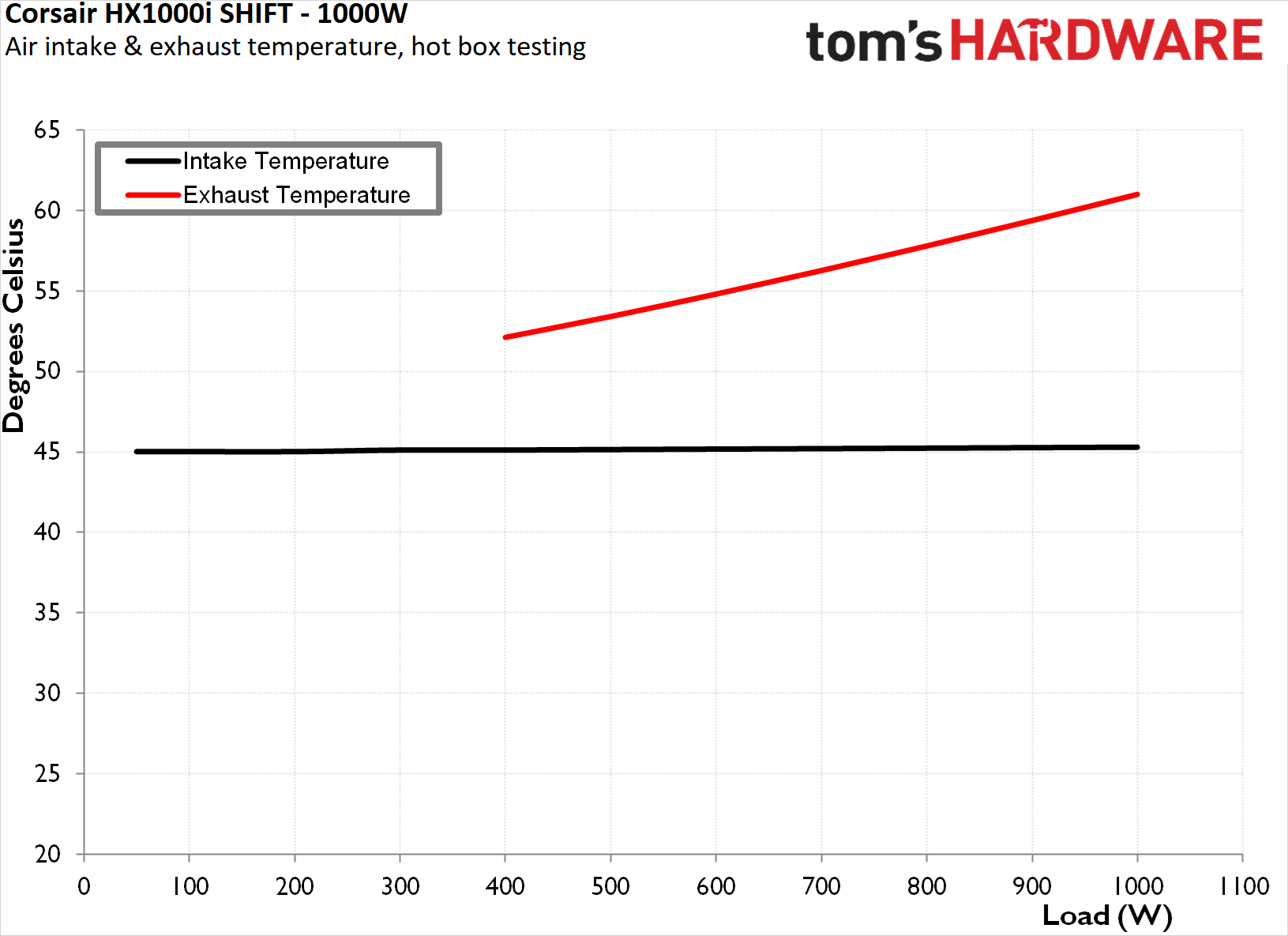
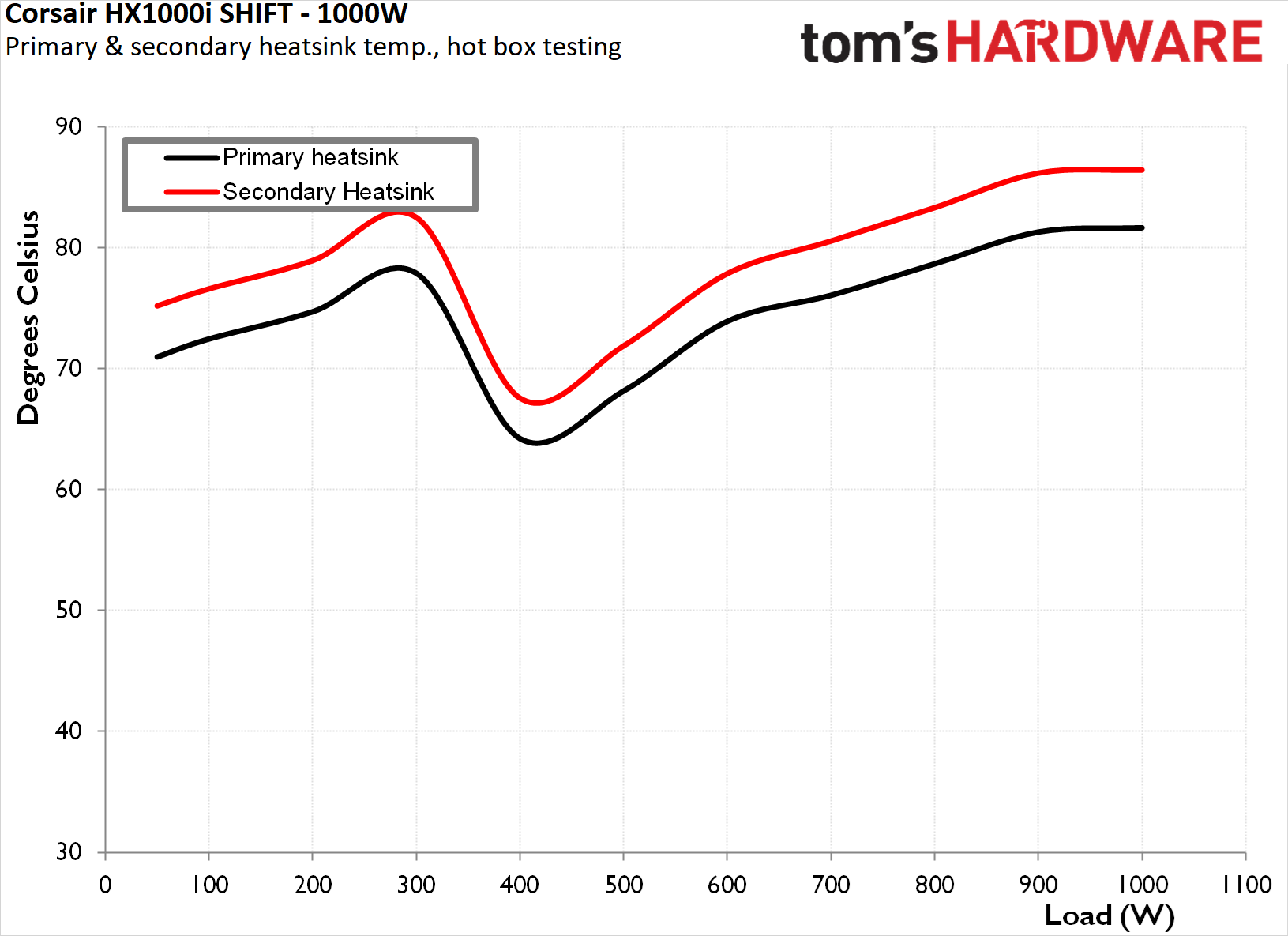
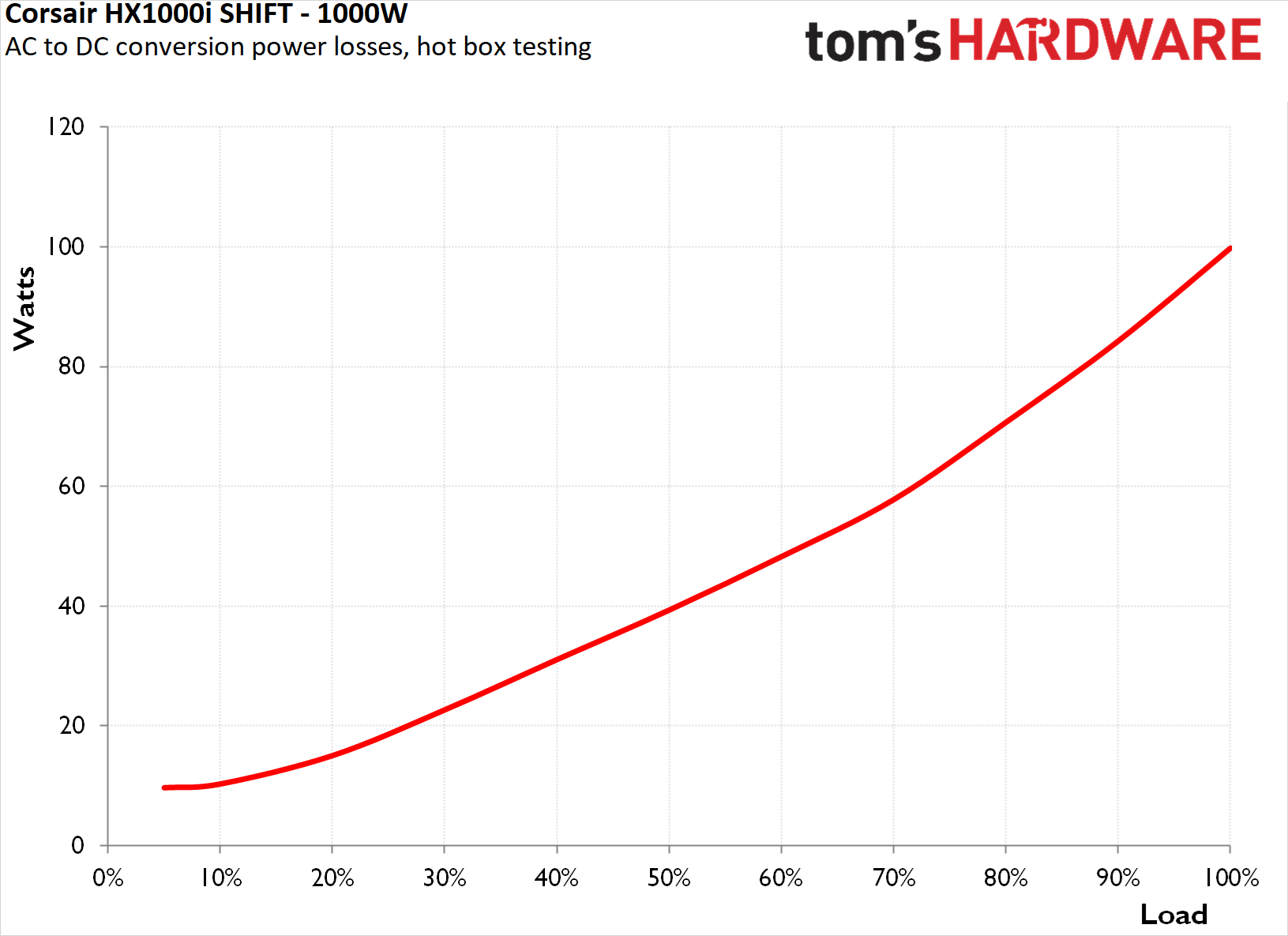
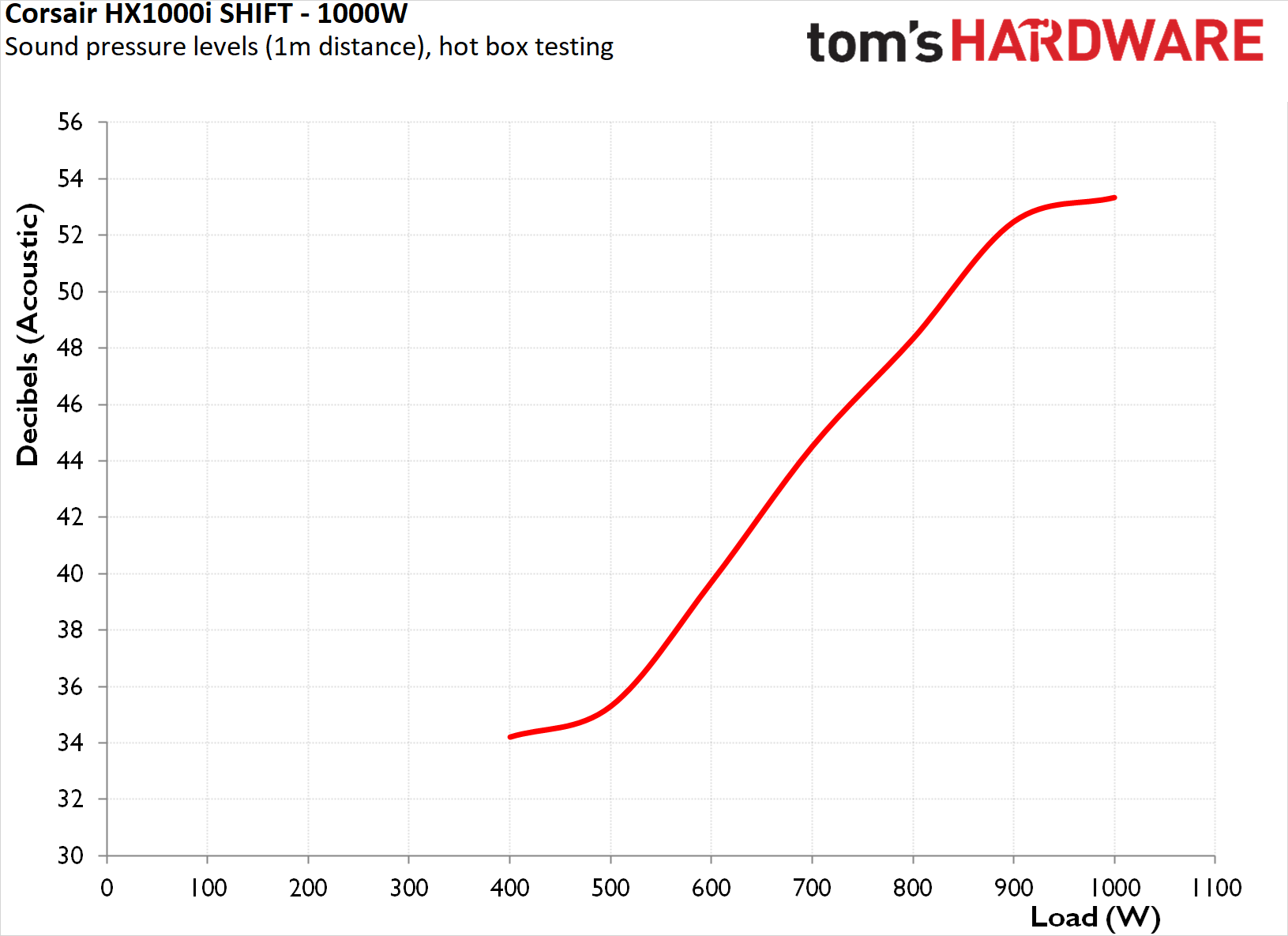
The fan profile under hot conditions reveals Corsair's conservative thermal management philosophy in full effect. Fan activation occurs somewhat earlier than during cold testing, and rotational speeds increase more aggressively as loads climb. Most notably, the fan exhibits a dramatic speed jump once load exceeds approximately 650-700W, transitioning from barely audible to clearly present. However, even this elevated speed level does not approach the fan's maximum capability. Internal temperatures remain comparably very low even at maximum load.
PSU Quality and Bottom Line
Power Supply Quality
The Corsair HX1000i SHIFT's electrical performance validates its flagship positioning, delivering metrics that match or exceed its competitors. Voltage ripple suppression proves exceptional across all rails: the 12V rail peaks at merely 26 mV, while the 5V and 3.3V rails achieve 16 mV and 14 mV respectively. These figures represent roughly one-quarter of the ATX specification's recommended limits, placing the HX1000i SHIFT among the cleanest power supplies available. Voltage regulation achieves near-perfection across all rails, demonstrating the benefits of CWT's sophisticated topology and premium component selection. The primary 12V rail maintains outstanding 0.7% regulation from 20% to 100% load. The minor 5V and 3.3V rails achieve even better results at 0.4% and 0.6% regulation respectively, specifications that exceed typical requirements substantially and ensure devices receive pristine power.
During our thorough assessment, we evaluate the essential protection features of every power supply unit we review, including Over Current Protection (OCP), Over Voltage Protection (OVP), Over Power Protection (OPP), and Short Circuit Protection (SCP). All protection mechanisms were activated and functioned correctly during testing.
Over Current Protection (OCP) triggers at sensible thresholds: 136% on the 3.3V rail, 138% on the 5V rail, and 118% on the 12V rail. Taking into account the 150 watt combined rating of the secondary lines, the OCP triggers are fairly high. On the other hand, the OCP trigger of the 12V line is a bit low for an ATX 3.1-certified unit. Nevertheless, these settings provide adequate headroom for transient current spikes while protecting against sustained overcurrent conditions that could damage components. Over Power Protection (OPP) activates at 119% under hot conditions, also quite low for an ATX 3.1-certified unit, suggesting that the designer was cautious regarding reliability.
Load (Watts) | 201.6 W | Header Cell - Column 2 | 502.75 W | Header Cell - Column 4 | 751.55 W | Header Cell - Column 6 | 1001.36 W | Header Cell - Column 8 |
|---|---|---|---|---|---|---|---|---|
Load (Percent) | 20.16% | Row 0 - Cell 2 | 50.28% | Row 0 - Cell 4 | 75.15% | Row 0 - Cell 6 | 100.14% | Row 0 - Cell 8 |
| Row 1 - Cell 0 | Amperes | Volts | Amperes | Volts | Amperes | Volts | Amperes | Volts |
3.3 V | 2.27 | 3.36 | 5.66 | 3.35 | 8.5 | 3.33 | 11.33 | 3.33 |
5 V | 2.27 | 5.04 | 5.66 | 5.04 | 8.5 | 5.02 | 11.33 | 5.02 |
12 V | 15.1 | 12.09 | 37.75 | 12.06 | 56.62 | 75.5 | 75.5 | 12.01 |
Line | Regulation (20% to 100% load) | Voltage Ripple (mV) | Header Cell - Column 3 | Header Cell - Column 4 | Header Cell - Column 5 | Header Cell - Column 6 | Header Cell - Column 7 |
|---|---|---|---|---|---|---|---|
| Row 0 - Cell 0 | Row 0 - Cell 1 | 20% Load | 50% Load | 75% Load | 100% Load | CL1 12V | CL2 3.3V + 5V |
3.3V | 0.6% | 12 | 10 | 16 | 14 | 12 | 16 |
5V | 0.4% | 12 | 12 | 16 | 16 | 12 | 16 |
12V | 0.7% | 14 | 12 | 18 | 26 | 22 | 14 |
Bottom Line
The Corsair HX1000i SHIFT exists at the intersection of innovation and pragmatism, forcing builders to weigh transformative cable management against compatibility constraints and premium pricing. From a purely electrical perspective, this unit performs magnificently. The voltage regulation can compete with virtually anything in the market regardless of price, ripple suppression achieves levels typically reserved for laboratory power supplies, and efficiency remains firmly in flagship territory across diverse loading conditions. Channel-Well Technology's proven platform heritage promises long-term reliability, while Corsair's premium component selection throughout - Japanese capacitors, Infineon MOSFETs, FDB fan - ensures this unit will likely outlive the systems it powers several times over.
The integrated iCUE Link System Hub transforms the power supply from simple infrastructure into ecosystem orchestrator for builders committed to Corsair's broader product family. This consolidation eliminates separate hub hardware, reduces motherboard header congestion, and simplifies software control for compatible fans, RGB lighting, and peripherals. For Corsair enthusiasts, this integration represents genuine value and convenience. For builders outside the ecosystem, these features will likely remain dormant.
Yet the HX1000i SHIFT's defining characteristic is its shifted connector arrangement that simultaneously represents its greatest strength and most significant limitation. When paired with compatible cases featuring appropriate PSU bay designs and cable routing provisions, this configuration delivers cable management that conventional power supplies cannot match. Cables route directly behind the motherboard tray without traversing visible spaces, creating builds where power delivery infrastructure essentially disappears from view. However, this architectural revolution demands specific case compatibility, typically requiring cases explicitly designed to accommodate this configuration. Builders must verify compatibility carefully before purchase – the very friction point that universal standards specifically aim to eliminate. For those with compatible hardware and cases, the benefits justify these constraints. For others, they represent unnecessary complications.
The retail price exceeding $340 creates the final barrier. This positions the HX1000i SHIFT firmly in premium territory, competing against flagship alternatives that may offer different feature sets or superior warranty terms. The Type-5 flat cables, integrated hub, exceptional electrical performance, and revolutionary cable management combine to justify premium pricing for target customers, but those customers represent a narrower segment than typical power supply purchasers. Mainstream builders seeking reliable 1000W power delivery will find numerous alternatives costing measurably less that deliver comparable electrical performance in conventional packaging.
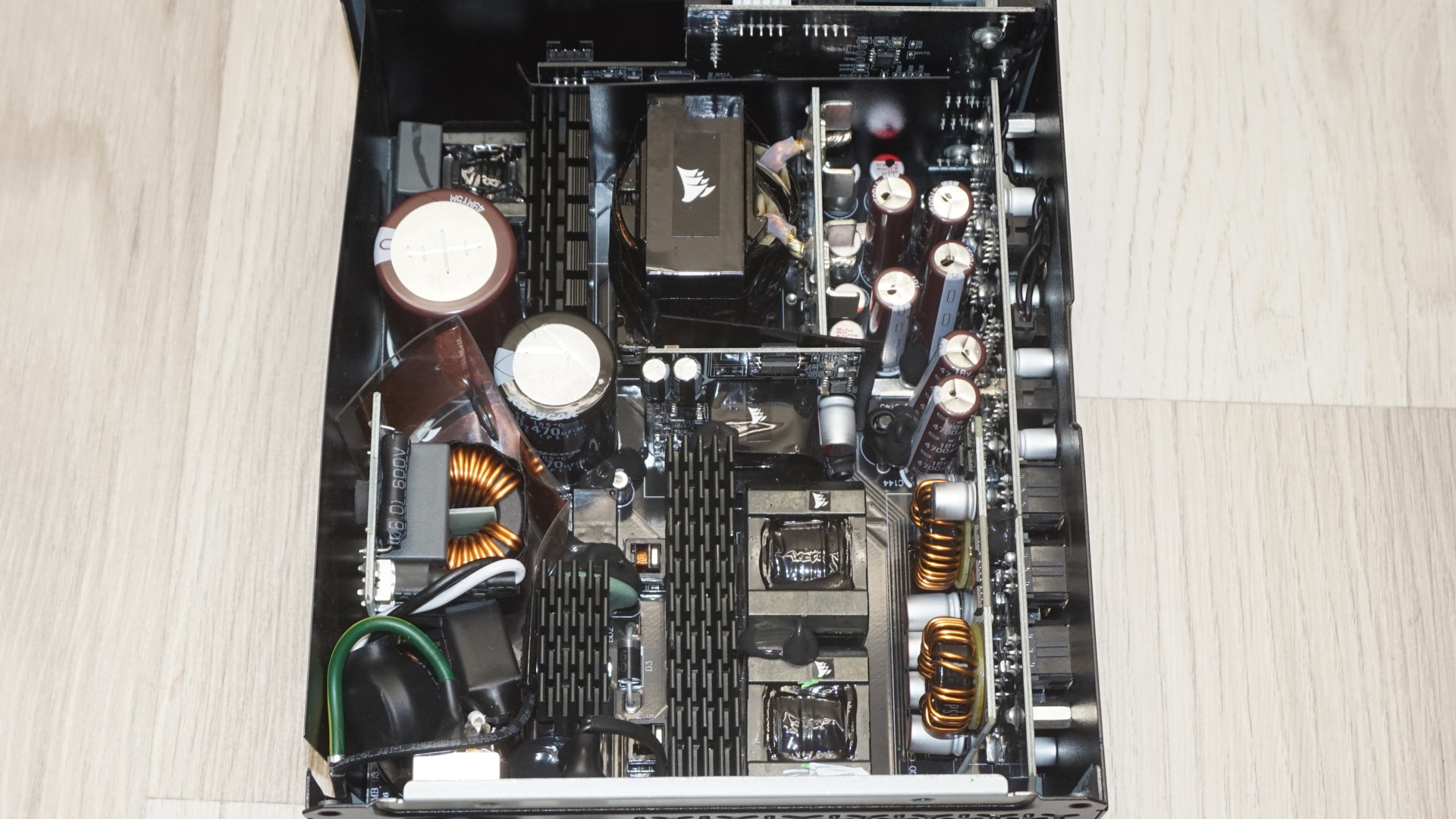
The Corsair HX1000i SHIFT ultimately succeeds brilliantly for its intended audience: Corsair ecosystem builders with compatible cases who prioritize cable management perfection and do not mind paying premiums for innovation. For this demographic, the HX1000i SHIFT represents one of the finest power supplies available, delivering flagship performance wrapped in genuinely transformative integration. Its ten-year warranty, zero-RPM operation, and exceptional build quality further strengthen the value proposition for buyers who appreciate engineering excellence. For builders outside this target demographic, such as those with incompatible cases, those unwilling to be limited to iCUE-compatible hardware, or those prioritizing value over ecosystem integration, the HX1000i SHIFT's innovations may not justify its premiums and constraints. These buyers would be better served by conventional alternatives offering comparable electrical performance without compatibility limitations. As such, the fundamental question is not whether the HX1000i SHIFT represents good engineering. We can certainly say that it unquestionably does. The question is whether its specific innovations align with your build requirements and whether you are prepared to embrace both its capabilities and its compromises. For the right builder with the right setup, this PSU achieves something genuinely special. For others, excellence exists in more accessible forms.
MORE: Best Power Supplies
MORE: How We Test Power Supplies
MORE: All Power Supply Content

Dr. E. Fylladitakis has been passionate about PCs since the 8088 era, beginning his PC gaming journey with classics like Metal Mutant and Battle Chess. Not long after, he built his first PC, a 486, and has been an enthusiast ever since. In the early 2000’s, he delved deeply into overclocking Duron and Pentium 4 processors, liquid cooling, and phase-change cooling technologies. While he has an extensive and broad engineering education, Dr. Fylladitakis specializes in electrical and energy engineering, with numerous articles published in scientific journals, some contributing to novel cooling technologies and power electronics. He has been a hardware reviewer at AnandTech for nearly a decade. Outside of his professional pursuits, he enjoys immersing himself in a good philosophy book and unwinding through PC games.
-
NorvilG Nice review, but two photos within the article appear to be from a beQuiet! PS.Reply
https://cdn.mos.cms.futurecdn.net/yyohixmqaxAMzjGRB4fmJ7-1200-80.jpg.webp


